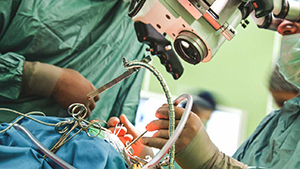Cancer Pain
Conveniently Located to Serve Dallas, Fort Worth, and the entire State of Texas
Cancer pain can be a major struggle – adding suffering to an already very difficult situation. When an individual experiences pain, it is not just limited to a part of the body – it affects almost every aspect of their life. Dr. Nader Pouratian provides effective treatment of cancer pain in Dallas to improve cancer patients’ quality of life.
Cancer pain, depending upon the type and intensity, can consume a lot of attention and hinder daily activities. It can make it difficult to focus on work and can cause trouble sleeping or eating. For those with little time left, it can make their remaining time very difficult.
Pain can also cause you to feel alone and depressed since people around you often do not understand the full extent of the pain. This can lead to irritation and frustration.
The intensity of cancer pain depends on factors such as the stage of cancer, its type, and the pain threshold of the individual.
What Causes Cancer Pain?
There are a number of potential causes of cancer pain. Sometimes, the chosen cancer treatment method causes pain. A surgical removal procedure can leave behind lingering pain. Headache and soreness are also common. Most often, it is simply the spread of cancer throughout the body, especially to the bones, that causes pain. The pain can be quite severe and may require assistance.
 Cancer Pain Treatment Options
Cancer Pain Treatment Options
There are several treatments available to offer relief from cancer pain. These treatment options are an effective and essential part of cancer therapy.
Cingulotomy
Cingulotomy focuses on the part of the brain that associates pain with a feeling of suffering. A probe is used to target the region, and then highly precise lesions are created. This relieves pain in 60-70% of patients. In some cases, patients will report that they still feel the pain but that it no longer bothers them. The procedure is quite safe and offers effective results.
Stereotactic Radiosurgery
Stereotactic radiosurgery is a non-invasive procedure that uses a high dose of radiation. It is often used to shrink tumors. In the case of cancer, the most effective targets for pain are the thalamus or the pituitary gland. When we treat the pituitary gland, it is called a radiosurgical hypophysectomy. A very high dose of radiation is focused on these regions, often resulting in pain relief within 1 week. The treatment is so precise that it can deliver radiation in such a way that it avoids damage to surrounding tissues. Radiosurgical hypophysectomy can cause hormone irregularities in the long term, so is usually used in patients who are seeking comfort toward the end of their disease.
Myelotomy
Myelotomy is a surgical procedure conducted in the spinal cord. The procedure involves making precise incisions in the midline transverse fibers of the spinal cord, where the sensory nerves are located. This interrupts pain signals to the brain, reducing pain related to cancerous tumors. This is most often used for patients with midline pain, like in the abdomen or pelvis.
Cordotomy
Cordotomy is a surgical procedure also conducted in the spinal cord. The procedure involves precisely placing a needle in the spinal cord using x-ray guidance. The needle is then used to precisely burn or lesion the tracts that carry the painful sensations from the body up to the brain. This is usually best for patients with pain on one side of the body.
Price of Treatment for Cancer Pain
The cost of your cancer pain treatment will depend on the type of techniques required to address your condition. These techniques will be chosen during your initial appointment.
Set Up Your Consultation
The best way to find out more about treatment options for cancer pain in Dallas is by contacting the office of Dr. Nader Pouratian. Schedule your informative consultation today.
Learn More
Learn more about Dr. Nader Pouratian’s treatment options for cancer pain for Dallas patients – contact our office and arrange your informative consultation.
Related Blogs

Treating Trigeminal Neuralgia with Balloon Compression
Trigeminal neuralgia is a chronic condition that causes a person to experience sharp jolts of pain in the face. The pain typically occurs in episodes that vary in severity and length… Read More

How Brain Surgery Stops Parkinson’s Disease Tremors
Experts say two types of brain surgery can have immediate results for Parkinson’s disease patients. However, they say oral medications should be tried first… Read More

UCLA neurosurgeons utilize virtual reality in treating patients
Pediatric neurosurgeon Aria Fallah donned virtual reality goggles and exchanged his surgical tools for two remotes to practice a brain surgery… Read More




